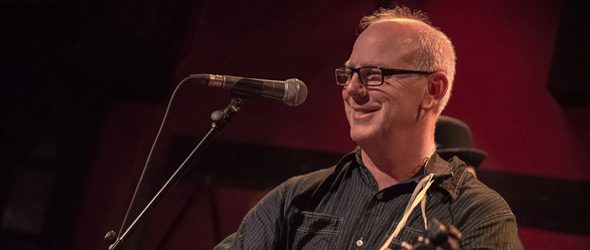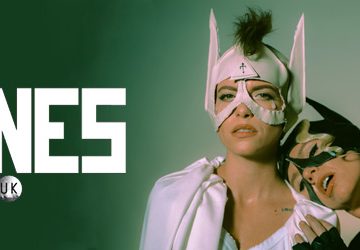Greg Graffin is best known as the lead singer in the seminal Punk band Bad Religion, which formed in 1979 when Graffin himself was only fifteen. Quickly making a name for themselves in the active Los Angeles Punk scene and over the next thirty-eight years, sixteen studio albums, several EPs and live albums, as well as compilations, Bad Religion are easily one of the most well-known and influential Punk bands of all time.
In addition to Bad Religion, Graffin has also earned a Ph.D. from Cornell, teaches courses on paleontology and life sciences at UCLA, and has authored several books on the topic of evolution and religion. Most recently, Graffin is gearing up to release his third solo album, Millport, on March 10, 2017. While he may be best known for his work with Bad Religion, his recent solo adventure allows Graffin to explore his Country Rock roots in an extraordinary way.
Eager to play the new music live, Graffin announced plans for select shows back in January, and on Tuesday, February 28th, played the second of three solo shows at New York City’s Rockwood Music Hall. With a capacity of only 150, Rockwood’s Stage 2 is a small, intimate venue that lets fans get up close and personal with musicians. This tiny venue is quite a change and a treat for fans used to seeing Graffin on much larger stages as part of Bad Religion.
Strangely, there was no opening band and Rockwood had a different, unrelated show slated for 8PM, which meant that Graffin and his band had less than an hour in which to cram their fourteen song set. The small wooden stage was packed with nearly a dozen various instruments, many of which would never be seen anywhere near a Punk show.
Despite Punk’s touting of inclusion, creativity, and free-thought, there is rarely any need for a banjo, fiddle, or mandolin in the music. Fans at Rockwood were in for something different, and that was exciting. Those familiar with Graffin’s previous solo albums, American Lesion (1997, Epitaph) and Cold as the Clay (2006, Anti-), know that they are a massive departure, and so it was fitting that the stage setup reflected those differences. The band – which featured Guitarist Tommy Andrews, Bad Religion drummer Jamie Miller, and fellow UCLA lecturer David Bragger playing multiple instruments – even had to walk through the loosely-packed crowd in order to carefully arrange themselves on the cramped stage.
Graffin and company seemed right at home in this intimate setting. It is easy to imagine Graffin giving college lectures, as he makes a point of making eye contact with the audience and has an easy, friendly way of speaking. After some mild banter, the band dove right into one of the first singles from Millport, “Backroads of My Mind.” The song is an infectiously catchy and classic-sounding Country Rock effort that sounded excellent with a full band. Graffin, clearly a fan of anecdotes, noted that these shows at Rockwood were the first time he played guitar in front of a group of people while standing up. He even had to fashion a guitar strap out of shoelaces and an old pair of jeans, all very befitting of the Country Rock/Folk genre.
Next, the band went into several more songs off Millport, including the softer, banjo-backed “Too Many Virtues” and the album’s title track, “Millport,” which allowed Graffin to show off his distinct voice and Bragger to display his exceptional skill with the fiddle. With “Rebel’s Goodbye,” a somber track from Cold As the Clay, Graffin took to the piano and seemed right at home behind it. He then stated that after spending his entire career criticizing religion, his band is called Bad Religion for a reason; people often asked him if there was “good” religion, and his answer was “music.”
Continuing to engage the room, he said that he wanted to write a Gospel-inspired song that was entirely secular and without any “supernatural” elements, and so he composed “Time of Need,” making sure to note that the song’s first lines are “Hey, man,” and not “Amen.” “Time of Need” blends Rock and Gospel influences but lacks the usual inspirational messages therein, instead lamenting that “no religion can help this time of need.” Though the song is simple at its core, it provided an opportunity to show the crowd how well Graffin’s live band can perform any genre put before them.
Before playing another track from Millport, “Lincoln’s Funeral Train,” Graffin described the song’s Bluegrass origins. Originally a song by Norman Blake, Graffin and his band rearranged the classic and turned it into an electric guitar-driven track that worked perfectly in the intimate setting and sounded more like Bad Religion than any of Graffin’s solo work. Graffin then took to the banjo, first explaining that the next song, appropriately titled “Sawmill,” was played in sawmill tuning, one of the banjo’s many possible tuning configurations. His skill with the instrument was impressive in spite of his saying that he had no formal training. Bragger also had several impressive, mesmerizing fiddle solos during “Sawmill,” despite the song’s short-run time.
“Echo on the Hill,” a fast-paced and harmony-filled Bluegrass track was perhaps the best show of each band member’s considerable skills, particularly Bragger who played the mandolin with blinding speed. After playing “Shotgun,” a song that Graffin described as fulfilling his dream of writing a “love song,” the band realized they had to cut their set short and so they then played the slow, dark “Highway” from Cold as the Clay.
The crowd cheered as Graffin joked that the next song was “for everyone who waited all night for a Bad Religion song.” The band played a rearranged version of “Sorrow,” one of Bad Religion’s most well-known songs from their 2002 album, The Process of Belief. This new Folk arrangement sounded completely different from the original recording, and yet it seemed as though the song was always meant to be performed that way. Nearly every member of the small crowd sang along and cheered as the set ended on a perfect note.
By the end of the night, Graffin had played nearly every song off Millport, except for “Waxwings,” which likely would have been the final song had the set not been cut short. Following the set, fans lined up to meet and chat with Graffin and his bandmates, a rare treat for fans used to seeing him in larger, impersonal spaces. Overall, the impeccable musicianship, fun attitude, and intimate atmosphere created by Graffin and his band made for an entertaining and unique, if all too brief, evening filled with great music. Hopefully Graffin and company will come through New York City again very soon.
Photos by: Scryer Photography

























No comment